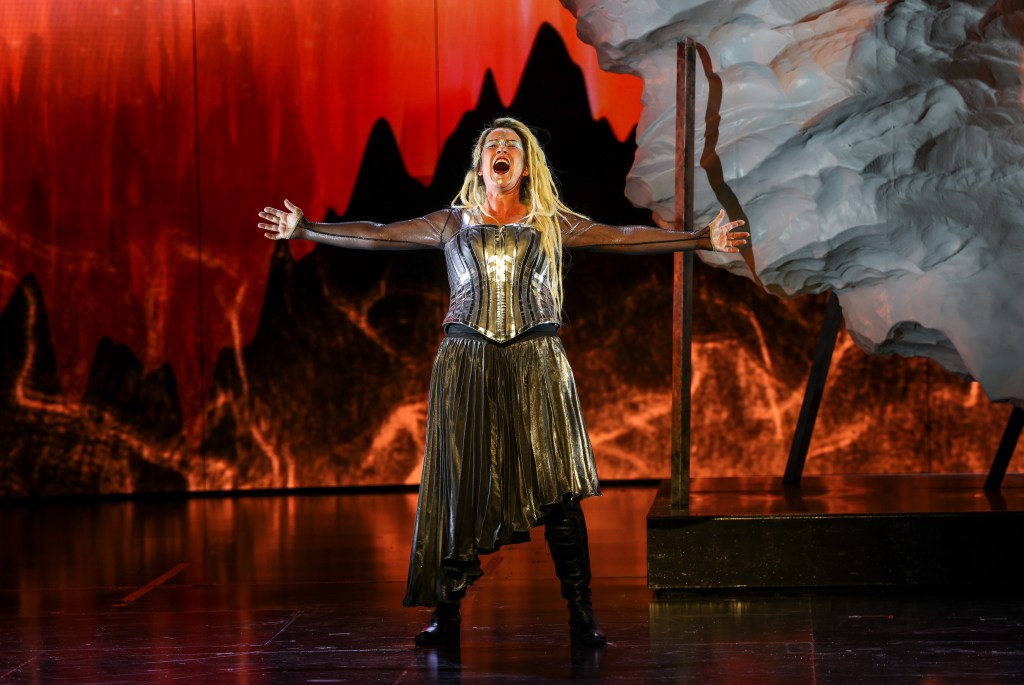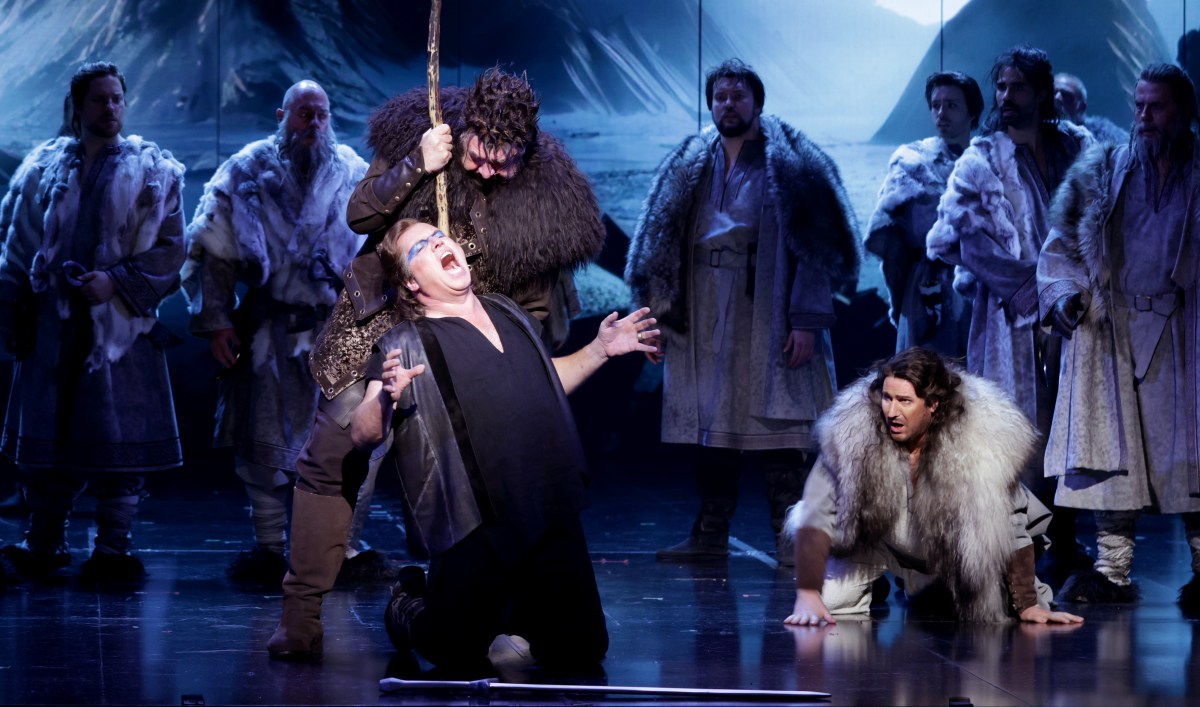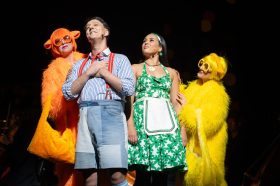Götterdämmerung, the Twilight of the Gods, brings the tetralogy of Wagner’s The Ring Cycle to an earth-shattering end with the death of key characters and the inevitable downfall of the gods. Though the end is not all doom and gloom, as we come to learn.
As director and production designer, Chen Shi-Zhen’s digitally-staged Ring Cycle represented near impossible Wagnerian staging directions across a broad spectrum of relevant imagery. Leigh Sachwitz and floras&faunavisions created some exceptional technological effects to help bring this vision to life. Complemented by a minimal number of mostly effective 3D-scanned set pieces, alongside Matthew Marshall’s atmospheric lighting and a range of mythologically-informed costumes by Anita Yavich, the overall effect was positive.
While some quirky design choices had a tendency to weaken really big moments, such as Alberich’s transformation into a serpent and toad in Das Rheingold and Siegfried’s final stabbing of the dragon, Fafner, in Siegfried, not so in Götterdämmerung. Here the blend of the digital with its moving LED panels, physical staging elements and the final huge ending worked almost seamlessly.
The Queensland Symphony Orchestra (QSO), under Philippe Auguin’s masterful baton, was also firing on all cylinders. All the intense orchestral colours of this score, alongside the power created in delivering such strong leitmotifs over the previous three operas, came together in Götterdämmerung. One could not have asked for a better reading musically. It was an engrossing and emotionally demanding four hours of music in which individual orchestral solos really shone.
The three Norns, daughters of Erda, goddess of the Earth, commenced with a prophetic scene that explained how Wotan gained wisdom by carving his powerful spear from the sacred ash tree. Rising slowly through trap doors in the stage to sombre, brooding music, the Norns spun the golden rope of world-knowing, wearing cleverly designed rope costumes, which they gradually unravelled. This image, alongside the changing spiderweb shapes of the panels, lit in glorious gold and yellow, was marvellously evocative. Olivia Cranwell, who made her debut as Sieglinde in this cycle, was a stand-out as the third Norn, her shimmering soprano rising high above the stave.
The darkness of the opening scene with its broken ropes that spell doom morphed into the bright light of day as Brünnhilde waved Siegfried off to fresh heroic deeds. Not understanding its power, he left Alberich’s ring with her and took her steed, Grane; a smaller version of the Valkyrie flying ship, complete with flapping wings, it was effectively used.
Siegfried fatefully arrived at the castle of the Gibichungs, ruled by the unmarried Gunther and his sister, Gutrune. A stunning digital design gave us a forbidding ice castle in deep green and black, swirling with snow. The stuff of Norse legend, or even Disney films, the characters were dressed in medieval furs and boots, a look continued for the chorus of Gunther’s vassals and hunters.
Their half-brother, the malevolent Hagen, son of Alberich, is a particularly despicable character. A short but powerful scene, in which Warwick Fyfe’s splendid Alberich spoke to the sleeping Hagen to spur him on to seize the ring, was dramatically chilling. Having already successfully played the other vengeful basses in The Ring, Hunding and Fafner, Andreas Silvestrelli made a first-rate Hagen. His voice was like an ominous thundercloud, that rumbled and occasionally spurted and fired. With the darkest of low notes and some fiery top ones, he played the sly and unctuous Hagen to perfection.
Luke Gabbedy made a very good fist of the gullible Gunther, with his strong bass-baritone, in what can often be a thankless role. His desire to marry and his trust in Hagen and later in his new blood-brother, Siegfried, was palpable. As his sister, Gutrune, Maija Kovalevska gave us an impressive lyric soprano with soaring top notes. She was delightful in her swooning attention to Siegfried, after he drank Hagan’s love potion, and distraught on discovering his death.
Meanwhile, Brünnhilde’s sister, Waltraute, seeks her out to beg help to save the gods, with their impending doom at stake if the all-powerful ring is not returned to the Rhinemaidens.
Looking every bit a Valkyrie, Deborah Humble’s impassioned mezzo rose with some glorious top notes, portraying the urgency of her plight. Anna-Louise Cole’s Brünnhilde passionately rebuffed her with suitable disdain, unwilling to part with Siegfried’s token of love.
Due to Hagen’s machinations with magic potions, though the audience must question our hero’s gullibility in drinking a bright pink potion from Hagen’s hunting horn, Siegfried has forgotten his past. He falls immediately in love with Gutrune while offering to win over Brünnhilde for Gunther and the two set off to find her. The scene ends with a marvellous soliloquy by Hagen as the castle images on the screens disintegrate.
Posing as Gunther, Siegfried uses the Tarnhelm to confront Brünnhilde in a well-delivered scene by them both when he wrests the ring from her finger. It results in her being brought back to the Gibichungs’ castle to marry Gunther where she discovers that Siegfried is to marry Gutrune. Finally, we see and hear Wagner’s only chorus in The Ring – a combined 70-voice strong Opera Australia and Opera Queensland chorus, who offered a huge sound to cheer on the wedding celebrations.
Brünnhilde’s vitriolic attack on both Gunther and Siegfried for deceit, treachery and infidelity shocks the massed ensemble.
Cole tackled these dramatic demands as competently and thoroughly as the musical fireworks, her physical prowess giving her an electrifying stage presence. Meanwhile, Siegfried’s character showed off his absolutely worst characteristics, with Brünnhilde’s love turning to hatred. With Hagen’s support, she contributes to plot his demise believing he has betrayed her.
The glorious watery scene with the Rhinemaidens, aerial performances mirroring the singers below, was a great opener to Act III. Having confidently and foolishly dismissed the Rhinemaidens’ death warning, Stefan Vinke’s Siegfried then arrived in the hunting scene, his powerful ringing top notes on display.

The scene that followed gave us some of best scenic imagery of the whole cycle. It revealed a spectacular bleak Icelandic landscape, with its dotted fires and fur-dressed hunters, not out of place in either the Dune series, Star Wars or The Lord of the Rings. A second potion loosened Siegfried’s tongue as he recounted his life story and his memory returned. Tricked by Hagen into remembering Brünnhilde, Vinke gave an animated performance before he died at Hagen’s hand, his Heldentenor rising gloriously and strongly in some thrilling singing, some of the best of the night. As he sang of Brünnhilde, a flock of black ravens flew ominously across the landscape emulating the orange flock of his father’s death. The concentric moons of his parents’ mismatch were also reimagined.
One of the great pieces of music in The Ring, the funeral march that followed was played with deep emotion by the QSO.
The finale, following Siegfried’s death, is a marathon sprint for the soprano and Cole sang the immolation speech with great passion and strength, her ability to cut through the powerful orchestration with some astonishing non-stop top notes added a fierce nobility to her delivery. As she mounted the pyre, a clear pyramid that was set alight from within, the various screen images came crashing down in bursts of brilliant colour, with fiery ring images. All the imagery seen on digital screens across the four operas then reappeared in reverse fast succession, as Valhalla disintegrated, though we were never treated to a vision of the fortress itself. A clever and well-timed touch was the aerial Rhinemaidens diving down to take the ring from Brünnhilde before she disappeared into the pyre.
The audience response to this electrifying and powerful musical ending was a 10-minute standing ovation. Moreover, Auguin made the unprecedented decision to bring the entire 120 members of the orchestra up on stage. They were warmly applauded, a gesture showing the holistic nature of such a work where music, orchestra, singers, production and design were integrated into a marathon 16 hours of opera. Wagner would have likely approved.
Götterdämmerung (Third day, music drama in a prologue and three acts)
Der Ring des Nibelungen (The Ring Cycle), Lyric Theatre, QPAC, Brisbane
A stage festival play for three days and a preliminary evening
by Richard Wagner, with libretto by the composer
Conductor: Philippe Auguin
Director: Chen Shi-Zheng
Associate Set Designer: Maruti Evans
Digital Content Designer: Leigh Sachwitz, flora&faunavisions
Interactive Content Design and Programming: flora&faunavisions
Costume Designer: Anita Yavich
Lighting Designer: Matthew Marshall
Choreographer: Akasa Ruthy Inchaustegui
Cast in order of appearance: Celeste Haworth, Angela Hogan, Olivia Cranwell, Anna-Louise Cole, Stefan Vinke, Luke Gabbedy, Andrea Silvestrelli, Maija Kovalevska, Deborah Humble, Warwick Fyfe, Lorina Gore, Jane Ede, Dominica Matthews
Opera Australia Chorus, Opera Queensland Chorus, Opera Australia Dancers, DanceNorth Australia, Queensland Symphony Orchestra
Götterdämmerung the fourth and final opera in Richard Wagner’s Der Ring des Nibelungen (The Ring Cycle), was at Lyric Theatre, QPAC, Brisbane on 7, 14 and 21 December.





